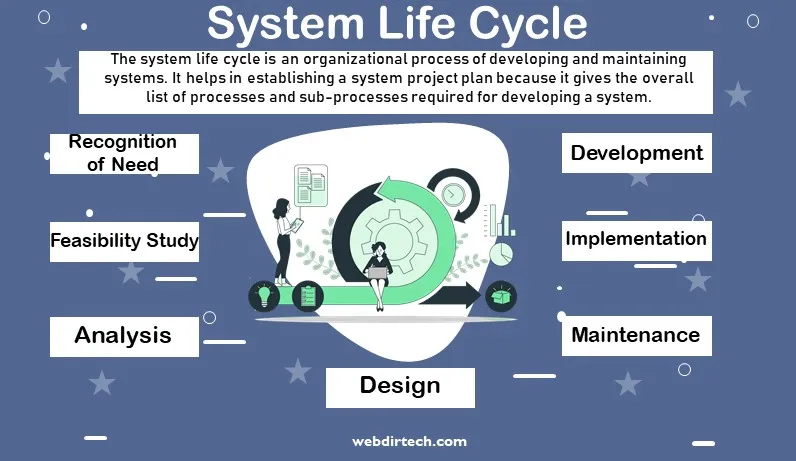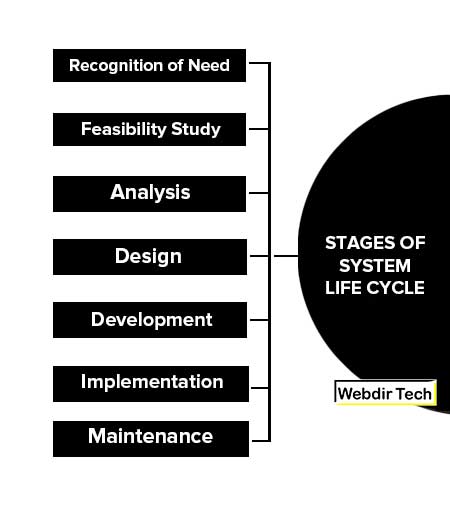What is System Life Cycle?
The system life cycle is an organizational process of developing and maintaining systems. It helps in establishing a system project plan because it gives the overall list of processes and sub-processes required for developing a system.
The system development life cycle means the combination of various activities. In other words, we can say that various activities put together are referred to as the system development life cycle.

In the System Analysis and Design terminology, the system development life cycle also means the software development life cycle.
System Development Life Cycle
Systems are created to solve problems. So, before a system is created, there must be a problem. Once the problem is defined, a system is developed to solve it. The investigation will result in finding out the best course of action:
- Whether to leave things as they are,
- Upgrade the current system,
- Develop a new computerized system.
If it is decided that a new system is to be developed, the next phase is analysis. The analysis involves carrying out a detailed study of the present system, leading to the specifications of a new system. As the weaknesses of the current system are identified, the user will specify what s/he wants out of the new system.
Here, the aim target of analysis is a specification of what the new system is to accomplish. Based on the user requirements, the new system must be designed. The features of the new system are specified and the costs of implementing them and the benefits of the system are estimated. Then, input, output, and processing specifications are drawn up in detail.
When the design is completed, implementation begins. Implementation involves the actual programming and testing of the new system. The system is then installed (put in place ready to be used) and is ready to go into operation.
When it is operating, the system may be monitored to determine if it is performing up to expectations, and if not, modifications (changes) will be made. As time goes by, the system may have to be changed because of changing requirements, like more customers, more employees, or even new technology.
Eventually, the useful life of the system comes to an end because changes are too expensive or the equipment used is outdated. It becomes necessary and economical to replace the old system with a new one. Thus the life cycle of a system ranges from problem definition to death.
Stages of System Life Cycle
The system life cycle is the name given to various tasks which have to be carried out when a new information technology system is being created. These are the stages of system life cycle:
- Recognition of Need
- Feasibility Study
- Analysis
- Design
- Development
- Implementation
- Maintenance

Recognition of Need
This is the first phase or you can say the foremost phase in any System Development Life Cycle (SDLC).
During this phase, the idea of developing an automated system is born and studies of the current problem and objective, benefit, and scope are undertaken as the saying goes “YOU CAN NOT DECIDE HOW TO GO UNLESS YOU HAVE DECIDED WHERE TO GO” unless the end objective is clearly stated, We’ll not to be able to know of the system achieved the objectives or it failed. The main questions in this phase answered are:
- What are the problems?
- What are the end objectives?
- What benefits are expected?
- What are the areas to be covered?
Feasibility Study
The feasibility study or simply saying initiation any system is the second stage under System Development Life Cycle (SDLC) during this phase, the system analyst interacts with the end user.
This interaction is to collect information about the current system, Drawbacks of that system, and suggestions for its improvement. The main questions answered in this phase are:
- What are possible solutions?
- What are possible alternatives?
- What benefits can be expected?
- What is time frame for development?
- What are resources requirements?
The above question answered regarding resources requirement and time frames is more important. These are normally represented in the form of cost-benefit analysis or economic feasibility. However, the three are:
- Technical Feasibility
- Economic Feasibility
- Operational Feasibility
Technical Feasibility
The system was developed using HTML, DHTML, JavaScript, VBScript, and ASP (Active Server pages).
- The site was developed with Windows as the operating system.
- The site is interactive i.e. user friendly, thus viewing information and the related features is easy.
Easy retrieval and access of data is provided.
Economic Feasibility
Economic feasibility is a cost-benefit keeping in view that the site is economically feasible. The system is economically feasible due to the following points: Benefits in reducing the cost are in the form of staff cut-off.
The cost incurred to implement the system is the payment of the data entry operator, a little maintenance required for the hardware and software from time to time consistency in efficiency.
Operational Feasibility
Operational feasibility is dependent on human resources available for the project and involves projecting whether the system will be used if it is developed and implemented. Operational feasibility is a measure of how well a proposed system solves problems and takes advantage of the opportunities identified during scope definition and how it satisfies the requirements identified in the requirements analysis phase of system development.
Operational feasibility reviews the willingness of the organization to support the proposed system. This is probably the most difficult of the feasibilities to gauge. In order to determine this feasibility, it is important to understand the management’s commitment to the proposed project.
If the request was initiated by management, it is likely that there is management support and the system will be accepted and used. However, it is also important that the employee base will be accepting of the change.
Analysis
The most important aspect of this phase is a thorough understanding of user requirements. If this phase is not properly completed then all probability the system will not satisfy the end user. A key question is “What must be done to solve the problem”.
One aspect of the analysis is defining the boundaries of the system and determining whether or not the candidate’s system should consider another related system. There are many tools that are audible to analyze i.e. interviews, questionnaires, and review of written documents and fact analysis.
The environment in which the analysis is carried out plays an important role i.e. how the system analysis deals with the staff organization. Major questions under consideration during analysis are:
- What is being done?
- How is it being done?
- Does a problem exist?
- If a problem exists, how severe is it?
- How frequently does it occur?
- What is the underlining cause for the problem?
Design
Once analysis is completed, the analyst has a firm understanding of “What is to be done”. The next step is to be deciding, “How the problem might be solved” Thus is the system design, we move from the logical to the physical aspect of the Life Cycle.
The information collected during the detailed analysis phase is used and models are prepared. Alternatives to achieve objectives are considered.
However, some of the considerations are:
- What data will be accepted and how it is captured?
- What output will be generated and in what format?
- What data will be stored, how, where, and how much time will be stored?
- What control, validation, and checks will be provided?
- What are the exact requirements in terms of computer H/W, Manpower, and other infrastructure?
In a nutshell, we can say that this phase produces a complete picture of the system.
Development
The fifth phase of SDLC is the development phase. This is the phase of the actual activity of creating the new automated system. The development phase consists of coding of computer programs compilation and testing of the programs, link testing, and integrating of software.
The development phase consists of many activities and these are:
- Coding programs to meet system specification
- Testing and debugging the programs
- Link testing separate programs into the system and testing system performance as a whole.
- Run the system with the trial data/test data o Prepare System documentation.
Implementation
During the implementation phase, the developed and thoroughly tested software is implemented for the user. During this phase, the user is in the driver’s seat. It is preliminarily concerned with the user training site preparation and file conversation.
During the final testing checks the readiness and accuracy of the system to access or update or retrieve data from new files. Once the program becomes available test data are read into the computer and proceed against the file produced for testing.
All systems are designed in a sense to substitute existing systems, so a major issue is the strategy to be used for replacing the old system with a new one, this is called implementation. The possible strategies include:
- Parallel implementation: In this both new and old systems are operated until the new system is sufficiently proven.
- Pilot operation: In this the new system is operated in a limited capacity until it is proven, then the old system is phased out as the new one is phased in.
- Cold turkey (the big bang) in this the new system is moved in one fell swoop and the old one is moved out.
Maintenance
When the implementation phase is completed and the user staff is adjusted to the change accredit by the system, the evaluation and maintenance begin like any system there is an aging process that requests periodical hardware and software.
If the new information is inconsistent with the design specification, then changes have to be made. Hardware also requires periodical maintenance to keep in tune with the design specification.
The importance is focused on bringing the new system to standard; this is the final step in the System Development Life Cycle (SDLC).
The maintenance phase of the software life cycle is the time period in which the software requirement is changed hence the software gradation is required or the software gives some errors so the testing is again required. Typically the development cycle span is much less than the span of the maintenance phase.
FAQs About System Life Cycle
What are the stages of system development life cycle?
The following are the stages of system life cycle:
1. Recognition of Need
2. Feasibility Study
3. Analysis
4. Design
5. Development
6. Implementation
7. Maintenance.
